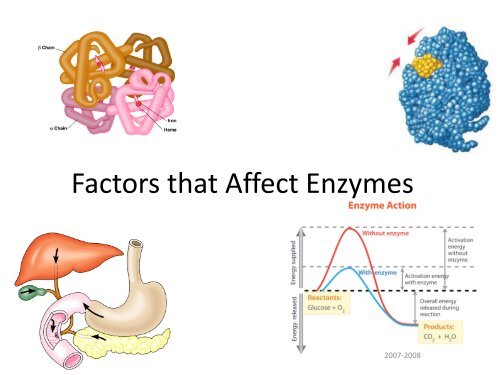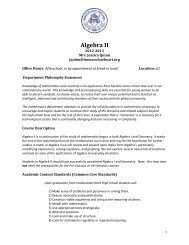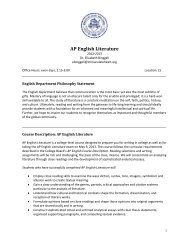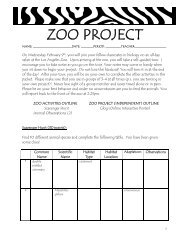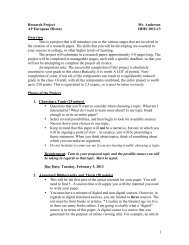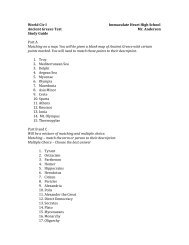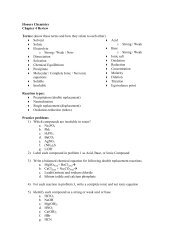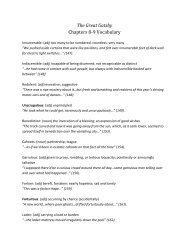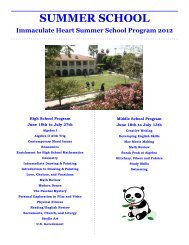Factors that Affect Enzymes
Factors that Affect Enzymes
Factors that Affect Enzymes
You also want an ePaper? Increase the reach of your titles
YUMPU automatically turns print PDFs into web optimized ePapers that Google loves.
<strong>Factors</strong> <strong>that</strong> <strong>Affect</strong> <strong>Enzymes</strong><br />
2007-2008
<strong>Factors</strong> <strong>Affect</strong>ing Enzyme Function<br />
• Enzyme concentration<br />
• Substrate concentration<br />
• Temperature<br />
• pH<br />
• Salinity<br />
• Activators<br />
• Inhibitors
Enzyme concentration
<strong>Factors</strong> affecting enzyme function<br />
• Enzyme concentration<br />
– as enzyme = reaction rate<br />
• more enzymes = more frequently collide with substrate<br />
– reaction rate levels off<br />
• substrate becomes limiting factor<br />
• not all enzyme molecules can find substrate
Substrate concentration
<strong>Factors</strong> affecting enzyme function<br />
• Substrate concentration<br />
– as substrate = reaction rate<br />
• more substrate = more frequently collide with enzyme<br />
– reaction rate levels off<br />
• all enzymes have active site engaged<br />
• enzyme is saturated<br />
• maximum rate of reaction
Temperature
<strong>Factors</strong> affecting enzyme function<br />
• Temperature<br />
– Optimum T°<br />
• greatest number of molecular collisions<br />
• human enzymes = 35°- 40°C<br />
– body temp = 37°C<br />
– Heat: increase beyond optimum T°<br />
• increased energy level of molecules disrupts bonds in<br />
enzyme & between enzyme & substrate<br />
– H, ionic = weak bonds<br />
• denaturation = lose 3D shape (3° structure)<br />
– Cold: decrease T°<br />
• molecules move slower<br />
• decrease collisions between enzyme & substrate
How do ectotherms do it?
pH<br />
pepsin<br />
trypsin
<strong>Factors</strong> affecting enzyme function<br />
• pH<br />
– changes in pH<br />
• adds or remove H +<br />
• disrupts bonds, disrupts 3D shape<br />
– disrupts attractions between charged amino acids<br />
– affect 2° & 3° structure<br />
– denatures protein<br />
– optimal pH?<br />
• most human enzymes = pH 6-8<br />
– depends on localized conditions<br />
– pepsin (stomach) = pH 2-3<br />
– trypsin (small intestines) = pH 8
<strong>Factors</strong> affecting enzyme function<br />
• Salt concentration<br />
– changes in salinity<br />
• adds or removes cations (+) & anions (–)<br />
• disrupts bonds, disrupts 3D shape<br />
– disrupts attractions between charged amino acids<br />
– affect 2° & 3° structure<br />
– denatures protein<br />
– enzymes intolerant of extreme salinity<br />
• Dead Sea is called dead for a reason!
Compounds which help enzymes<br />
• Activators<br />
– cofactors<br />
• non-protein, small inorganic compounds<br />
& ions<br />
– Mg, K, Ca, Zn, Fe, Cu<br />
– bound within enzyme molecule<br />
– coenzymes<br />
• non-protein, organic molecules<br />
– bind temporarily or permanently to<br />
enzyme near active site<br />
• many vitamins<br />
– NAD (niacin; B3)<br />
– FAD (riboflavin; B2)<br />
– Coenzyme A<br />
Fe in<br />
hemoglobin<br />
Mg in<br />
chlorophyll
Compounds which regulate enzymes<br />
• Inhibitors<br />
– molecules <strong>that</strong> reduce enzyme activity<br />
– competitive inhibition<br />
– noncompetitive inhibition<br />
– irreversible inhibition<br />
– feedback inhibition
Competitive Inhibitor<br />
• Inhibitor & substrate “compete” for active site<br />
– penicillin<br />
blocks enzyme bacteria use to build cell walls<br />
• Overcome by increasing substrate<br />
concentration<br />
– saturate solution with substrate<br />
so it out-competes inhibitor<br />
for active site on enzyme
Non-Competitive Inhibitor<br />
• Inhibitor binds to site other than active site<br />
– allosteric inhibitor binds to allosteric site<br />
– causes enzyme to change shape<br />
• conformational change<br />
• active site is no longer functional binding site<br />
– keeps enzyme inactive<br />
– some anti-cancer drugs<br />
inhibit enzymes involved in DNA synthesis<br />
• stop DNA production<br />
• stop division of more cancer cells<br />
– cyanide poisoning<br />
irreversible inhibitor of Cytochrome C,<br />
an enzyme in cellular respiration<br />
• stops production of ATP
Animation<br />
http://bcs.whfreeman.com/thelifewire/content/<br />
chp06/0601s.swf
Irreversible inhibition<br />
• Inhibitor permanently binds to enzyme<br />
– competitor<br />
• permanently binds to active site<br />
– allosteric<br />
• permanently binds to allosteric site<br />
• permanently changes shape of enzyme<br />
• nerve gas, sarin, many insecticides (malathion,<br />
parathion…)
Allosteric regulation<br />
• Conformational changes by regulatory<br />
molecules<br />
– inhibitors<br />
• keeps enzyme in inactive form<br />
– activators<br />
• keeps enzyme in active form<br />
Conformational changes<br />
Allosteric regulation
Feedback Inhibition<br />
• End product inhibition is negative feedback used to regulate<br />
the production of a given molecule.<br />
• The initial substrate is a molecule <strong>that</strong> is altered in three<br />
steps by enzymes 1,2 and 3. The end product will combine<br />
with enzyme 1 to stop the reaction so there will not be an<br />
excess production of the end product..
Feedback inhibition<br />
threonine<br />
• Example<br />
– synthesis of amino acid,<br />
isoleucine from amino<br />
acid, threonine<br />
– isoleucine becomes the<br />
allosteric inhibitor of the<br />
first step in the pathway<br />
• as product accumulates it<br />
collides with enzyme more<br />
often than substrate does<br />
isoleucine
Don’t be inhibited!<br />
Ask Questions!<br />
2007-2008


